
Table of Contents
- Crate Training A Puppy: Step-by-Step Guide
- How to Crate Train a Puppy: 20 Tips and Tricks
- 1. Make Your Dog's Crate Inviting and Familiar
- 2. Create a Positive Association with the Crate
- 3. Cover Your Puppy's Crate
- 4. Get the Right Sized Crate
- 5. Increase the Duration They Stay In The Crate
- 6. Don't Give in to Whining
- 7. After Potty Breaks, Take Puppy Back to the Crate
- 8. A Tired Dog is a Good Dog
- 9. Move Your Napping Puppy to the Crate During the Day
- 10. Praise Calm and Quiet Puppy Crating
- 11. Look into Heartbeat or Soothing Toys
- 12. Give Your Puppy a Familiar Smell
- 13. Try Warm Toys or Towels to Soothe an Anxious Puppy
- 14. Talk to the Dog When Crate Training
- 15. Place a Liner or Tray Under the Crate
- 16. Use Radio or TV for Crate Training a Puppy
- 17. Never Use the Crate as Punishment
- 18. Safe Distractions in the Dog's Crate
- 19. Don't Make a Song and Dance About Leaving
- 20. Keep Your Puppy's Crate with You at Night
- 21. Adding a Verbal Cue for Going In The Crate
- 22. Feed Your Puppy's Meals In The Crate
- Crate Training A Puppy: Common Questions
- Crate Training A Puppy: Closing Thoughts
Crate-training dogs can be a useful tool, but not all dogs will fall in love with their crates.
The training itself can sometimes be difficult.
Crate training a puppy, in particular, will often present challenges for dog owners.
In this article, we will cover:
- how to crate train a new puppy (or puppy kenneling) step-by-step
- how long to crate train a puppy
- what age to start crate training a puppy
Fortunately, there are some tricks you can implement to make the process quicker.
Crate training young puppies has several purposes, but most commonly, it's for potty training and keeping dogs out of trouble.
When pet owners use a dog's crate effectively, this can become an invaluable tool.
Once trained and housebroken, it's best to keep the kennel open and leave it be so that your puppy can have a place to relax that is all their own.
Crate Training A Puppy: Step-by-Step Guide
Step 1: Pick the right crate
Picking the right crate for your dog is essential. We will touch more on this in the tips and tricks section. But choosing the crate that best fits your dog's needs and yours for training purposes is probably what will make this process much smoother.
Make sure the crate is the right type: steel/metal that's more open or a plastic-enclosed one.
Ask yourself if you are traveling, is the dog coming with you or staying? That also helps determine the right crate.
Also, be sure to pick the right size crate (more on this later…).

Step 2: Make your dog's crate a familiar, safe space
The introduction between your puppy and the crate is just as important as the next step.
The last thing you want to do is just shove your dog in there and then just disappear on the first experience.
You also don't want to interrupt their time of play and socializing and just put them in the crate. They will be alert and agitated which means they will most likely cry and whine.
It's best to wait until they have calmed down or are getting sleepy and are ready for a mid-day nap.
You need to plan out time to introduce them and reward them for going in the crate.
This helps create a positive relationship with going in the crate and will cause less friction when you are ready to leave and want them to go in there on their own accord.
Make the crate a comfortable experience (this tip is talked about in detail later).
At this step, you'll want to start with leaving the door open so they feel like they are not trapped
Step 3: Leave the house and slowly lengthen the time
This step is important because they need to know that if you are going to use the crate they may need to be comfortable being in the crate with the door closed and for periods of time.
Teach them by going for quick trips leaving your house.
I wouldn't recommend leaving for longer than 45 min to an hour to start off.
This part is important, along with rewarding them so they have a healthy relationship with the crate.
This will also teach them to hold their bowels because they will not want to relieve themselves in an area where they might sleep.
How to Crate Train a Puppy: 20 Tips and Tricks
1. Make Your Dog's Crate Inviting and Familiar
To start with the first tip on crate training, your puppy needs to feel comfortable to want to be in the crate.
To get your puppy to use the crate, you need to make the crate look more appealing.
At first glance, the puppy's crate may appear overwhelming or scary to your puppy, so add a cozy blanket or puppy toy so it becomes soft and inviting.
You can even add a sweatshirt of yours so that they have your scent.
New puppy owners may ask for a towel or cloth with the mother's scent on it as well, which is a good idea.
This can be very inviting and calming for the puppy by providing them with a familiar and comforting scent, which studies show is very effective.
2. Create a Positive Association with the Crate
Anytime you want your puppy to enter or use their crate, make sure that you are doing so in a positive mindset.
Do this by using a friendly tone of voice, offering some treats, and giving praise to the dog.
You can also create a positive association when crate training a puppy by feeding the young dog in his crate with the door open.
This creates a positive association between food and the crate.
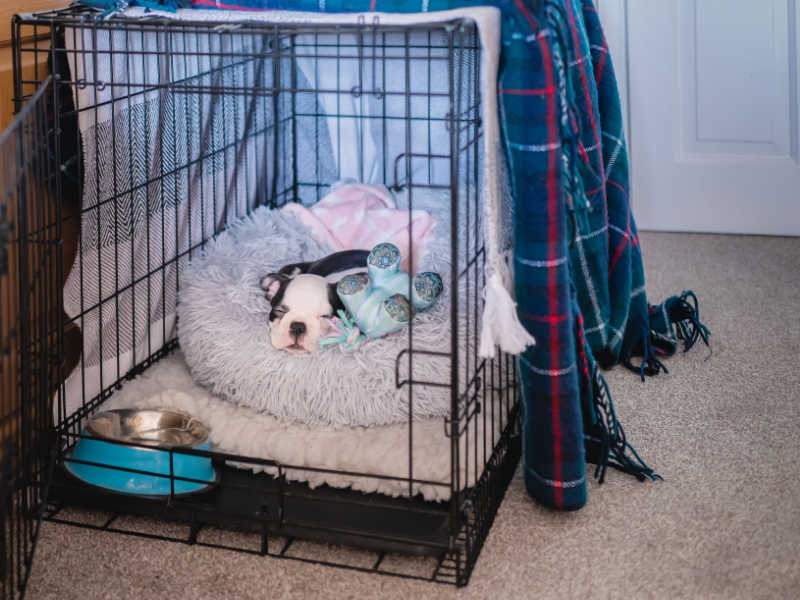
3. Cover Your Puppy's Crate
If those two don't work and you are still asking, “HOW DO I CRATE TRAIN MY PUPPY”? We are just getting started, and by the end of this, you'll have plenty of ammunition to test.
For some young puppies, the crate can induce anxiety if they can see their surroundings but not interact with them.
They may whine, scratch at the crate, or bark.
If this sounds like your puppy, try placing a blanket or sheet over the crate so that your puppy can't see out.
Some companies sell dog crate covers that are specially designed for this purpose.
Such dog crate covers are more expensive than a normal sheet or blanket, but they tend to block out light, sending your puppy off to sleep.
4. Get the Right Sized Crate
Crate training takes time, so you have to be patient with them.
A dog will rarely potty in the same area that they sleep in.
The exception to this rule is when they have been forced to hold it for too long or they have an upset tummy or bladder infection, or when dog crate size is wrong (too large).
If you give your puppy a crate that is too big, they will find a place to sleep and a place to potty, all within the same space.
Thus, you want to buy a crate that is only large enough for a place to sleep.
The rule of thumb is that your puppy should be able to stand up and turn around in their kennel but have no more room than that.
If you want to avoid purchasing multiple dog crates as your puppy grows, you can purchase an adult-sized crate with a divider. The divider will allow you to section off a small part when crate training a puppy and keep extending it every few months.
5. Increase the Duration They Stay In The Crate
When crate training a puppy, slowly increase the time they spend in there.
Slowly increase the time each week as they get older, but don't overdo it.
Creating a positive association with the crate also means not overusing the puppy crate.
Imagine if you were put in a cage for 8 hours at a time every day – it's likely you wouldn't want to go in there either.
Crate training a puppy should be done responsibly.
Minimize the amount of time your puppy spends in their crate and always abide by the maximum crating time guidelines below.
These guidelines are based on how long a puppy can hold their bladder.
- 8-10 weeks – 30-60 minutes
- 11-14 weeks – 1-3 hours
- 15-16 weeks – 3-4 hours
- 17+ weeks – 4-5 hours
6. Don't Give in to Whining
Most new puppy parents are ready to throw the towel in on puppy crate training after the first night of crying or whining.
It's inevitable that this might happen since crating is a new thing for the young dog, but stick with it without giving in; it will get easier.
If your puppy whines or barks in their crate, you may want to take them straight out with a leash to go potty just to be sure they don't need to go.
After coming back in, however, put your puppy right back in the crate and shut the door.
7. After Potty Breaks, Take Puppy Back to the Crate
As mentioned above, after coming inside in the middle of the night after your puppy's potty break, put your dog right back into their crate.
You are trying to teach the dog a routine and set a schedule to which your pup can get used.
This means no momentary stop off on your bed for cuddles and no game of tug since it would disrupt the training.
8. A Tired Dog is a Good Dog
When leaving the house or at bedtime, if you find that your puppy barks excessively or gets themselves all worked up, try exercise.
Before leaving your puppy in their crate, play a more vigorous game of tug with them, take them on a long(ish) walk, or do anything to get your pup worn out.
This means that your puppy will be fast asleep while you are out or sleeping because they're tired.
This is a rule that will apply throughout your dog's lifetime.
Problem behavior can almost always be remedied with more stimulation and exercise.
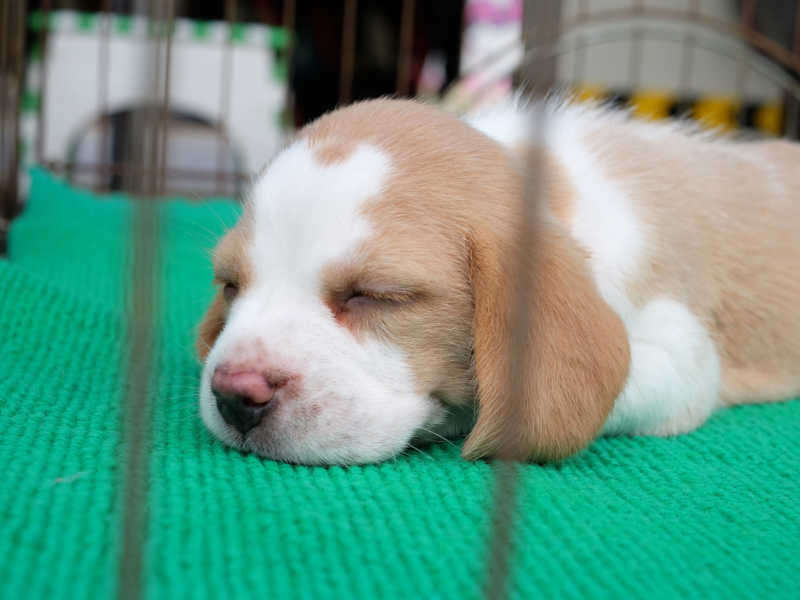
9. Move Your Napping Puppy to the Crate During the Day
To get your puppy used to their crate, move them into the crate when they nap during the day.
For example, if your dog falls asleep in the living room, carefully pick them up and put them in their crate.
If the crate is in the same room, you can leave the door open so that they can leave once they wake up.
If you do this, however, keep an eye out for them waking up because wake-up time is often potty time.
10. Praise Calm and Quiet Puppy Crating
Studies have proven that dogs respond to positive reinforcement much better than they respond to negative reinforcement.
To make puppy crate training more effective, instead of chastising a barking puppy in their crate, praise a puppy after a good session in their crate.
Be sure not to praise the dog when he has first settled in his crate because you may wake him or remind him that you are leaving.
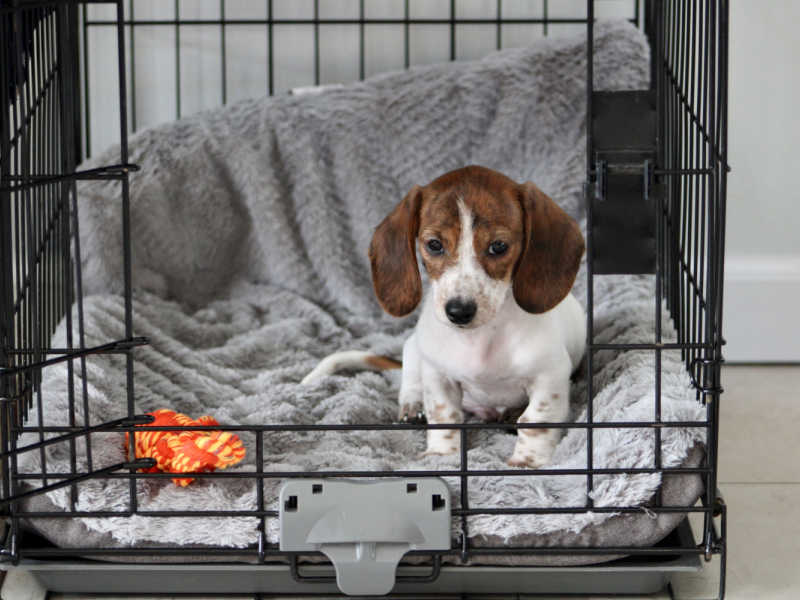
11. Look into Heartbeat or Soothing Toys
Young puppies, in particular, have trouble adjusting to sleeping alone after being with their mother and siblings before.
Put soothing puppy toys in your dog's crate, like the heartbeat bear or snuggle dog toy.
Such toys replicate the rhythm and sound of a heartbeat and can lull the dog to sleep when in a crate.
12. Give Your Puppy a Familiar Smell
Studies show that dogs have a favorite scent – it's their owner. So a familiar smell can help to soothe your dog.
If the puppy has developed an attachment to you, then a sweatshirt with your scent can offer comfort.
If the puppy is newly home, try to have a towel or cloth with the mother or sibling's scent on it.
The scent is one of the strongest methods of evoking memory, so it can be particularly helpful for dogs suffering from separation anxiety.
However, make sure that the item is safe for them and cannot be ingested.
13. Try Warm Toys or Towels to Soothe an Anxious Puppy
Just like heartbeat toys, warm towels or warm toys can offer comfort by simulating a sibling or mother's body heat.
You can purchase microwavable insert toys for this purpose or you can simply roll up a towel after putting it in the dryer to warm it up.
And again, anything you place in your dog's crate, make sure it's safe and cannot be ingested.
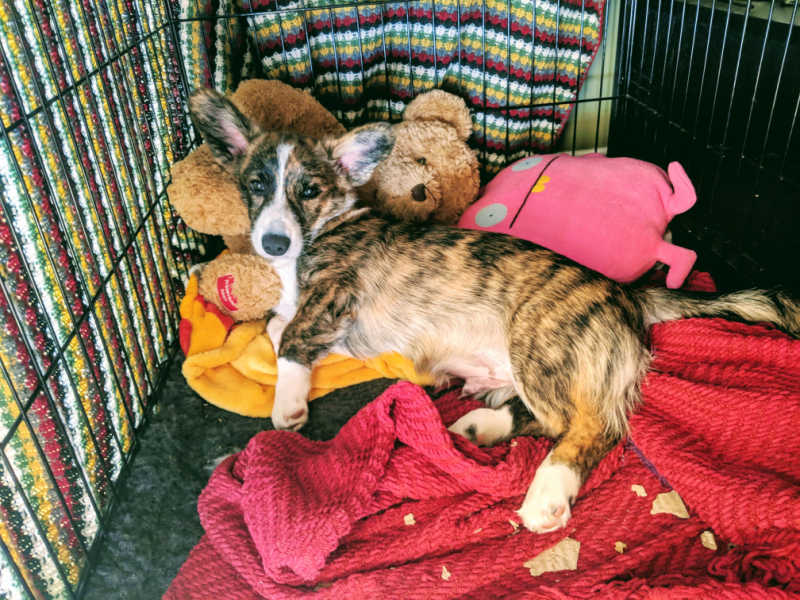
14. Talk to the Dog When Crate Training
Some new puppy owners swear by talking to their puppies while they are in their crate at bedtime as part of crate training.
For example, if your puppy seems anxious or distressed when you put them in the dog crate at bedtime, get into bed but talk to them softly. This reminds them that you are still in the room and they are not alone.
Often a puppy is only anxious because they are going from sleeping with multiple siblings to being all on their own. Simply letting them know that someone else is there with them can be enough to settle the dog down.
15. Place a Liner or Tray Under the Crate
If you adhere to maximum crating time guidelines when crate training a puppy, you should not experience any potty accidents.
Occasionally, however, you may get stuck in traffic, or your puppy may have had a little too much to drink, and this can result in the dog peeing in the crate.
To save leakage onto your floor, buy some puppy potty pads or some liner tray to go under the crate
16. Use Radio or TV for Crate Training a Puppy
Another way to let your puppy know that they are not alone when you leave the house is to leave the television or play some calming music on for him.
For some dogs, this is soothing and will send them right to sleep.
For other dogs, however, this noise can create suspicion or anxiety, so it's up to you to find out how your dog feels about disembodied voices.
An alternative to music would be a white noise machine which helps with anxiety.
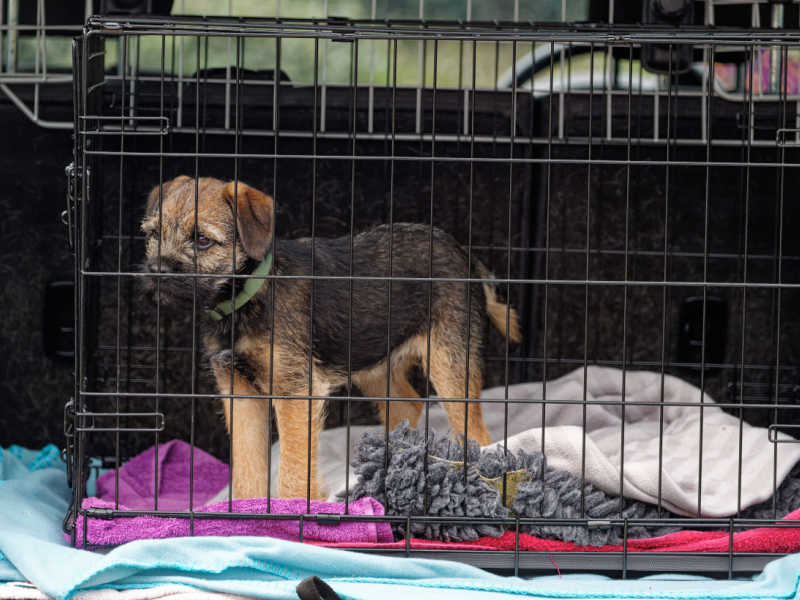
17. Never Use the Crate as Punishment
As mentioned before, it's important that your dog has positive associate with the create.
This means that you should never use your puppy's crate as a means of punishment, i.e., do not lock up the dog in a crate after he misbehaves.
Every time the puppy goes into their crate, it should be with a positive attitude, or you are going to create mixed messages.
18. Safe Distractions in the Dog's Crate
Distractions can keep your puppy entertained while they are in a dog crate.
The most common distraction used by pet owners worldwide is a KONG toy filled with peanut butter.
You can also give your dog an ice cube to play with or a safe, interactive toy.
These things will keep the dog busy so that you can slip out of the house unnoticed.
19. Don't Make a Song and Dance About Leaving
When you do leave the house, whether your puppy is in their crate or your adult dog has free roam, don't make a big fuss about leaving.
This is likely to increase the dog's separation anxiety, so don't make a big song and dance about it, or your pup is going to get anxious – simply sneak out quietly as if it's business as usual.
20. Keep Your Puppy's Crate with You at Night
Although many pet parents keep puppy crates in the bathroom or kitchen so potty accidents are easier to clean up, crate training a puppy is much easier if you keep the kennel close to you at night, at least in the beginning.
Doing this lets your puppy know that they are not alone because they can hear your breathing and can smell you.
21. Adding a Verbal Cue for Going In The Crate
It's the perfect moment to add a verbal cue when your pup is peacefully staying in its crate.
This is simple!
Just teach your puppy how to behave using a word or phrase, I personally use the term, “night night.”
No matter what time it is in the day, she knows exactly what that means and hops in her crate.
If I'm leaving the house, I typically give her a kong toy with peanut butter.
It's crucial that repetition happens, and you have to stay consistent in this process.
If he or she gets it right, reward them with a treat!
If you get to this point where they get in on command and lay in there peacefully, then crate training has been a success.
Protip: Don't modify your speech halfway through. Try to keep repeating the word or phrase you've chosen.
22. Feed Your Puppy's Meals In The Crate
We recommend your puppy eat food in the crate on day one.
This makes your dog feel more comfortable while in a cage.
This is also another positive association in their crate training.
Your pup will be more motivated to get in the crate if they know they will be fed.
As they become more comfortable in the crate, you can phase this tip out and have them eat their meals outside the crate.
Crate Training A Puppy: Common Questions
How long should I ignore my puppy whining in crate?
If it's been at least 30-45 minutes, and your puppy is still whining,
Check to see if they have to use the bathroom.
After they use the bathroom, put them right back in the crate.
Now knowing that you've handled that make sure they are comfortable in the crate, if they immediately start whining then ignore them until they stop.
This is all a part of crate training, and it will take some time to get past this stage.
How Long Should You Crate Train a Puppy?
The most common answer you'll get from vets is to expect 6 months of crate training.
However, if you are going to use the crate often when you leave, you should only leave them in for one hour for each month of age.
A word of caution: you should not crate your puppy for long periods of time.
If you are keeping them in the crate while you are at work, arrange times to let them out, feed them, or walk them.
What Age to Start Crate Training a Puppy?
You can start as soon as possible, about 8 weeks or 9 weeks, so they can acclimate to being in a crate quickly without causing a big fuss.
The longer you put off crate training as a new dog owner, the harder it will be when you start.
Crate Training A Puppy: Closing Thoughts
Crate training a puppy can be challenging but not impossible.
We all have to go through this trial to be honorary dog owners.
Hopefully, these tips surrounding crate training helped give you inspiration and put you at ease. Don't worry, you got this!
READ NEXT: 16 Tips For Crate Training A Dog – Effective Step-by-Step Strategy
Disclosure: We may earn affiliate commissions at no cost to you from the links on this page. This did not affect our assessment of products. Read more here and find full disclosure here.












